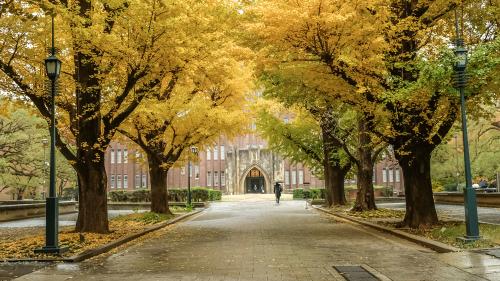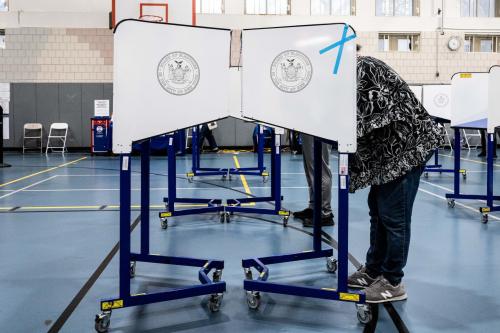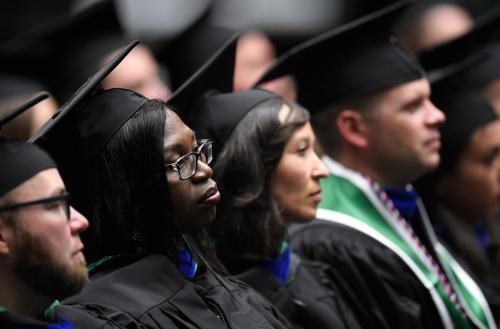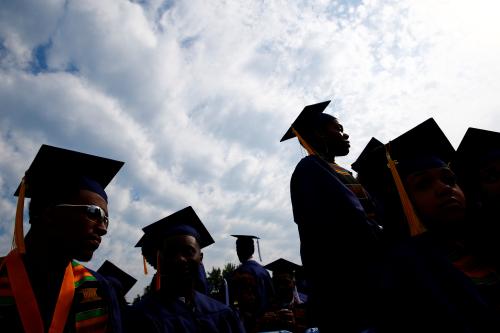In a prior post, I argued that charter schooling had become the litmus test issue for Democrats on the K-12 side. In higher education policy, that mantle is clearly held by college affordability and, specifically, free college and loan forgiveness policies. These will be key topics of conversation from now through the Democratic convention.
Why is college affordability getting so much attention? The short answer is that the price of college is rising, which affects everyone who is even thinking of college. For many, it also translates into more student debt. But there are other reasons why student loan debt is rising and why the issue is garnering so much attention. Here is a breakdown:
1. Rising college prices, due in part to declining state support
While I don’t have space here for a full analysis of rising college prices (and others have done this quite well already), I want to emphasize two things. First, while prices have been rising, they have actually been rising more slowly over the past decades than they were in the past. From 1998 to 2018, the net price (price net of aid and grants, including room and board) has been increasing at about 1.4% annually in private, non-profit colleges, 0.2% annually in public two-year colleges, and 3% in public four-year colleges (adjusted for inflation). These small but steady increases are expected in a service industry like higher education—especially when accompanied by declining government support. Any increase in college prices will tend to increase average borrowing per student.
2. Declining interest rates
The interest rates on college loans (and almost everything else) have been declining for decades, which lowers the cost of borrowing, and makes loans more attractive than in the past. This partly explains why students are more apt to take out loans, and pay them off more slowly, than before. This role of declining interest rates has received too little attention in the college debt conversation.
3. Rising share of students attending college and, with it, the number of borrowers
The number of people with college debt is rising because more students are going to college. This is good news, but this also means more than 44 million people—roughly 18% of the entire electorate—now have college loans outstanding.
4. Increasing number of disadvantaged students in college
While even high-achieving low-income students attend college at relatively low rates, there has been some improvement in recent years. However, these students, even with the benefits of Pell Grants, typically have to borrow for college.
The first four points above help explain why student loan debt is increasing. This means we have more and more students borrowing more and more money. Three additional factors have altered perceptions of the problems and created some problems of their own:
5. Rising default rates
The default rate on student loans rose from about 7.5% to 9% in public four-year colleges from 1998 to 2012, and from 17% to 23% in public-two year colleges. A recent Brookings post by Judy Scott-Clayton predicts that the default rate for the 2004 cohort of college students could reach 40% by 2023. (Default rates can be defined in different ways, and the rates rise considerably when they track individuals over a long period of time.) This suggests that the improved job opportunities that come with college have not kept up with debt levels.
6. Alarming and exaggerated headlines
We do have a debt problem, though the media have exaggerated it somewhat. For example, they often report the percentage of students with more than a $100,000 in student loan debt even though most of these students are in graduate school. Also, they tend to exaggerate the rise in college prices by failing to adjust for inflation or talk about how net prices (the ones actually relevant to families) have increased more slowly. These misleading headlines drive public opinion and political conversation.
7. Increasing unfair practices, mostly by for-profit colleges
There are now more reports than I can count about how for-profit colleges lure students in with big promises and encourage them to take out loans, even though they do not seem to improve employment prospects. The default rate on loans for students attending for-profit colleges is twice that of public and non-profit colleges. Much more has been written about for-profits, but the key point here is that they are increasing the perception that student loan debt is the result of a kind of scam.
8. Changing political winds
The focus on college affordability has been further amplified by the political focus on income and wealth inequality. Higher education is widely seen as an inequality elixir, but one that is only viable if low- and middle-income families can pay for it.
In some ways, the college affordability problem is not as bad as it seems. While college prices have been increasing, the rate of increase has slowed. While student loan debt has been rising, the burden of any given debt level, with low interest rates, has declined. While default rates are rising, those rates are actually below what they were in 1996. Finally, while for-profit colleges present a problem, the vast majority of students attend public and non-profit colleges that have better track records on average.
Still, we do have a real problem. We are at $1.5 trillion in student loan debt and counting. How might we address this?
Free college as a possible solution
Among the Democratic presidential candidates, the most talked-about solution to the affordability and debt problems is free college. In addition to obviously reducing the price of college for students, this has the advantage of simplifying the financial side of college and reducing students’ uncertainty about it. Students don’t have to understand the complex FAFSA form or the byzantine way in which the “expected family contribution” is calculated, nor do they have to worry that all of it might change the next year. Free is free.
But free college also has some disadvantages. It is fiscally costly. It runs against the “benefit principle”—that those who benefit from college should pay. It eliminates the price mechanism as a way of keeping a lid on costs. Relatedly, some argue that students should have “skin in the game” in college so that they take their courses more seriously. (I’m more skeptical of this last one, for the simple reason that college is costly even when tuition is free, because students could be doing other things, like working, if they are not in class. They always have skin in the game when it comes to college.)
Moreover, since higher-income students are much more likely to attend college and college financial aid programs are already designed to target resources to those with lower incomes (especially through the Pell grant program), most free college programs are regressive–they target additional resources disproportionately to students from relatively well-off families.
The details of free college programs vary. So, below, I lay out some of the main options and which of the Democratic candidates is supporting them. There are really three big questions we have to ask of any free college proposal: Which students are eligible? Which colleges are eligible? And what type and share of costs are covered?
Specific proposals from the candidates
Three main versions of free college have emerged at the federal level:
Free public undergraduate college (supporters: Sanders and Warren)
Sanders has the most well-known proposal. Its core elements are fairly simple: Sanders would provide additional government funds equal to current undergraduate tuition levels at public institutions (two-thirds federal with the remainder coming from states). His program would include two-year and four-year colleges. Limiting this to students attending public institutions helps to reduce the fiscal cost, though the bill would still come to $47 billion in federal funds each year.
Sanders’ interest in making free college means-tested has ebbed and flowed. His recent statements and campaign website make no mention of a family income threshold, even though an earlier proposal did.
Free community college (supporters: Biden, O’Rourke[?])
President Obama proposed this in 2015. As David Leonhardt recently wrote, this approach has many advantages: it is both cheaper (only about $13 billion per year in the long run) and more progressive (i.e., better targeted toward low-income students). An additional advantage: labor shortages, now and going forward, are likely to come from jobs that require only degrees and certificates from community colleges.
Biden and O’Rourke have both expressed support for free community college, though they have also done so for the other proposals. Also, in O’Rourke’s case, all we seem to know is from one campaign speech, without formal proposals.
Debt-free college (supporters: Harris, Buttigieg, O’Rourke, Booker)
The key difference between “free” and “debt-free” is the expected family contribution. That is, colleges have a cost of attendance and middle-income and wealthier families are expected to pay a share of that based on a complex formula. With debt-free college, the government would pick up the tab for the difference between the cost of attendance and the expected family contribution so that students, in principle, don’t have to borrow. Since families are still expected to pick up a share of the tab (especially middle- and high-income families who make up a disproportionate share of college students), this approach is cheaper, other things being equal. But it is also therefore less generous and lacks the simplicity and certainty of free college.
Buttigieg initially made headlines when we expressed skepticism of free college, but quickly clarified that he opposes broad-based programs that are not means-tested. Rather, he supports “completely free” college for low-income students (meaning that it would cover living expenses, too) and tuition-free college for middle-income families. This highlights the importance of looking at the fine print of the proposals.
O’Rourke has also made positive statements about debt-free college, but he did not sign on to the debt-free college bill introduced in the House.
Loan forgiveness (supporter: Warren)
Warren has proposed a different approach to the problem. The various free college programs would help future students but not address the existing $1.5 trillion in student loan debt. Warren has proposed forgiving almost $1 trillion of this debt.
It is little wonder why a politician would propose loan forgiveness. With one in five voters affected, it is hard to imagine any proposal that would directly benefit more voters than this one. As I show below, however, this comes with some real problems.
Good policy?
In a recent Brookings report, I summarized recent evidence on free college programs around the country and a randomized trial I led in Milwaukee. This evidence reinforces that most of the above proposals pass a cost-benefit test—meaning that the myriad benefits (improved skills, health, and reduced crime, to name a few) exceed the costs in the long run.
That’s a pretty low bar, however. The fact that the returns to education are so large means that almost any education program or policy that works at all passes a cost-benefit test. (This is based on an extensive cost-effectiveness analysis I carried out on college access programs for which we had rigorous evidence about their effects on college entry and completion. Unfortunately, it is not available online.). But some options are clearly more cost-effective than financial aid. That is, some programs do a better job of increasing college access and success.
The only one of the four policies that fails a basic cost-benefit test is loan forgiveness. The reason is simple: those with student loans have already received their education. Many of the benefits for these students will arise with or without loan forgiveness.
A potential alternative justification for loan forgiveness is that students did not understand what they were signing up for or have been misled about the benefits of specific college programs. This is true for many students who attended for-profit colleges and loan forgiveness for these students might make sense. But Warren’s plan is much broader-based and would give generous payout mostly to students who received a good education for the money they paid, and who will benefit from that for years to come. Broad-based loan forgiveness therefore mostly protects the very people who are best situated to protect themselves—those who have already received higher education.
Yet another potential justification for loan forgiveness is that it might particularly help low-income students. (Cost-benefit analysis doesn’t usually account for such equity concerns.) That’s true to a point, but an analysis by the Urban Institute shows that the majority of the benefits will go to students whose families have income above $75,000 per year. So, loan forgiveness is neither efficient nor equitable.
Of all the policies proposed so far by any candidate, this is the clearest example of “good politics meets bad policy.” Broad-scale loan forgiveness has enormous political upside with so many voters affected, but with very limited benefits on the policy side. A more reasonable approach, as Sue Dynarski recently argued, is to simply fix the loan repayment system.
We could also limit loan forgiveness targeted to those who have been misled by colleges (see above on for-profit colleges) or to those who have very low incomes (akin to income-based repayment, this would be income-based forgiveness).
It’s also worth pointing out that loan forgiveness goes hand in hand with free undergraduate college. It would make no sense to forgive the debt and then start the process all over, having future generations accumulate new debt. So, the $1 trillion dollar price tag for Warren’s loan forgiveness plan comes with another bill: another $47 billion per year, every year, for free college (and that ignores the costs to the states).
Free college, too, might have some unintended problems in the long run. Federal free college proposals push some of the costs to the states, which are already struggling to pay current bills. This is only going to get worse as health care costs and public employee pensions costs grow. We already know from the last 20 years of state budgets what gets cut when state budgets get tight—higher education. Free college would mean colleges and universities have no way to make up that lost revenue. In the long run, this would likely mean that resources would dwindle and quality would suffer.
Conclusion
There are many reasons why college affordability and student debt have become real concerns. Some of the problem is exaggerated, but we really do need a way for people to invest in themselves and in their futures without feeling like they have to bankrupt themselves in the process.
As usual, however, there are different ways we might tackle the problem, and some are clearly better than others. What we should aim for are policies that increase the level of education in the least expensive way possible, especially for those least able to afford college. Four approaches seem best-suited to meeting these goals:
- Targeted free college (e.g.. means-tested or targeted to community colleges).
- Increased federal support for colleges and universities. Free college makes college cheaper for students but is likely in the long run to reduce total resources going into higher education. While this is not currently being discussed, some colleagues and I have proposed something like this in the past.
- Continued improvement in loan repayment systems, such as income-based repayment.
- Increasing (really, reintroducing) accountability for colleges with high default rates and low future employment rates for students, which do more harm than good.
With 44 million adults (read: voters) having student loan debt, loan forgiveness might be the most politically attractive policy imaginable. However, if the goal is to improve college access and success in higher education, especially for low-income and middle-class families, we can do better.







